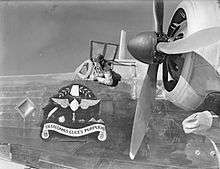No. 37 Squadron RAF
No. 37 Squadron was a Royal Air Force squadron of the First and Second World Wars.
| No. 37 Squadron RAF | |
|---|---|
| Active | 15 April 1916 - May 1916, 15 September 1916 – 1 July 1919, 26 April 1937 – 31 March 1946, 15 April 1946 – 1 April 1947, 14 September 1947 – 7 September 1967 |
| Country | United Kingdom |
| Motto(s) | "Wise without eyes"[1] |
| Battle honours | Home Defence, 1916-18*: Norway 1940: Dunkirk*: Channel & North Sea, 1939-40: Fortress Europe, 1940*: Malta, 1940,1942*: Greece, 1941*: El Alamein*: Italy, 1943-45*: South-East Europe, 1943-45* Honours marked with an asterisk are those emblazoned on the Squadron Standard |
| Insignia | |
| Squadron badge heraldry | A hawk hooded, belled and fessed, wings elevated and addorsed |
| Squadron codes | 37 Apr 1937 - Apr 1939 FJ Apr 1939 - Sep 1939 LF Sep 1939 - Mar 1946 |
History
No. 37 Squadron of the Royal Flying Corps was formed at RFC Orfordness, Suffolk, on 15 April 1916 as an experimental squadron, but it was disbanded a month later when it was absorbed back into the experimental station at Orfordness.[2] In September of that year, it was re-formed, with its headquarters at Stow Maries, in Essex. It responsibilities included defending London against aerial attack. Operating out of aerodromes along the East Anglian coast they flew against German Zeppelins, bringing down the L48 on 17 June 1917.[3]
The squadron became part of the new Royal Air Force in 1918 and in March 1919 moved to Biggin Hill and in July 1919 it was renumbered as No. 39 Squadron RAF.
In April 1937, the squadron was re-formed as No. 37 (Bomber) Squadron from a nucleus provided by No. 214 Squadron RAF. By the outbreak of World War II its equipment consisted of Vickers Wellington bombers.

In November 1940, the squadron moved to the Middle East. In January 1944 it moved to Foggia Tortorella (Foggia 2), sharing the base with USAAF B17 Fortresses. The Wellingtons were replaced by B24 Liberators in early December 1944. On 2 October 1945 the Squadron moved to Aqir Palestine but returned to Shallufa near Suez port Egypt in December from where it was disbanded on 31 March 1946. On 15 April 1946, No. 214 Squadron RAF at Fayid was renumbered No. 37 which flew Avro Lancaster bombers until it was disbanded again on 1 April 1947. It reformed again in Palestine on 14 September 1947, once again flying Lancasters. In May 1948, at the time of the British withdrawal from Palestine, the squadron moved to RAF Luqa in Malta, coming under the control of AHQ Malta.[4] In August 1953 the squadron converted to Avro Shackleton bombers and in July–August 1957 four of the squadron's aircraft moved to RAF Khormaksar in Aden where they continued to be known as 37 Squadron.[5] They remained there until the squadron disbanded on 7 September 1967.
The colours of 37 Squadron are in All Saints' Church, Stamford.
See also
References
- Pine, L.G. (1983). A dictionary of mottoes (1 ed.). London: Routledge & Kegan Paul. p. 265. ISBN 0-7100-9339-X.
- Halley 1980, p. 69
- http://www.angliamfc.org.uk/history.htm accessed 29 January 2007
- Lee, Wings in the Sun, 1989, 165.
- Lee, Wings in the Sun, 1989, 207
- Cole, Christopher; Cheesman, E. F. (1984). The Air Defence of Britain 1914–1918. London: Putnam. ISBN 0-370-30538-8.CS1 maint: ref=harv (link)
- Halley, James J. (1980). The Squadrons of the Royal Air Force. Tonbridge, Kent, UK: Air Britain (Historians) Ltd. ISBN 0-85130-083-9.CS1 maint: ref=harv (link)
- Jones, H. A. (1931). The War In The Air: Being the Story of the part played in the Great War by the Royal Air Force: Volume III. Oxford: The Clarendon Press.CS1 maint: ref=harv (link)
External links
| Wikimedia Commons has media related to No. 37 Squadron RAF. |